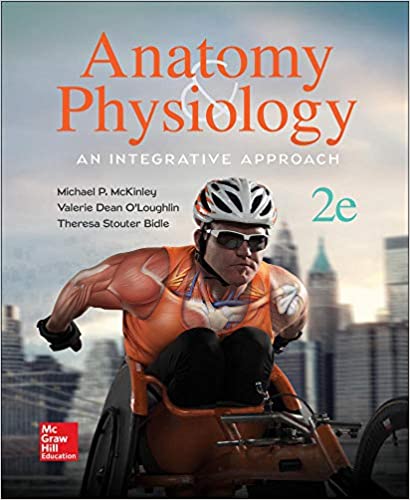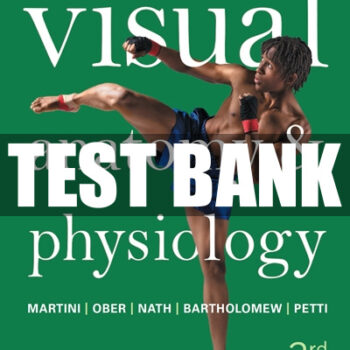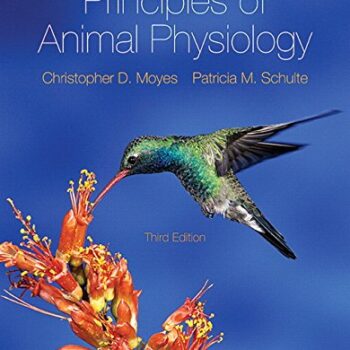
Test Bank For Anatomy And Physiology Integrative Approach 2nd Edition by McKinley
Original price was: $55.00.$19.00Current price is: $19.00.
Digital item No Waiting Time Instant DownloadISBN-13: 978-0078024283 ISBN-10: 0078024285
Hello and welcome to Test Bank For Anatomy And Physiology Integrative Approach 2nd Edition by McKinley. This material is been prepared for students who would be able to comprehend the diverse complex systems of the human body. This would also allow you to break down important concepts in anatomy and physiology that you need to practice in order to perfect your skills.
An Explanation of Anatomy and Physiology Integrative Approach
As the Human Anatomy and Physiology Integrative Approach implies, it focuses on Integration, this test bank encompasses cells, tissues, organ systems, and their interdependence and interrelation. With this test bank, find out how muscles contract, how the nervous system functions, and a whole lot more.
Advantages of our Test Bank
Inevitably, the majority of exercises that comprise the test bank involve single or multiple-choice, true/false, and fill-in-the-blanks. Our test bank is extensive and varied hence can be handy for you in exam preparation.
The comprehension of concepts is made easy by punctuating each question with explanatory comments. For instance regarding how kinetic energy differs from potential energy about human body functions.
- Critical Thinking Skills Enhancement Questions: These questions are really engaging as they require you to evaluate, vital information, especially in relation to the application of the content. You will come across situations that require you to evaluate the interaction of body systems in an analytical manner.
- Availability: With our test bank being digital, its accessibility is unpredictable. You do not need to worry anymore about the delays in delivery as you can start learning right away.
Main Features of Our Test Bank
- MCQs: It’s a Multiple Choice Questions test for students to examine their memories concepts and understanding of the topic.
- T/F Questions: These will answer the specifics of anatomy and physiology in a reduced number of statements.
- Cloze Exercises: These will enable you to integrate your past knowledge by remembering all the crucial parts that you have to understand.
Where to Purchase Our Test Bank?
Our Test Bank For Anatomy And Physiology Integrative Approach 2nd Edition By McKinley prepares students well not only for examinations but also paves a solid base in anatomy and physiology as a discipline. The material provided is designed in such a way that it is interesting to read and helps in memory retention which is key in passing medical exams.
Summary
We believe that the Test Bank For Anatomy And Physiology Integrative Approach 2nd Edition by McKinley helps students who want to be successful in the area of anatomy and physiology. We have included many different questions and closely detailed answers, as well as directed you to engage in higher-order thinking skills which means you are in control of your learning. Our understanding of the human body is enjoyable—initiate now!
Test Bank For Anatomy And Physiology Integrative Approach 2nd Edition by McKinley
Chapter 03 Energy, Chemical Reactions, and Cellular Respiration
True / False Questions
1. Stored energy is described as potential energy.TRUE
Bloom’s Level: 1. RememberLearning Objective: 03.01.01 Describe the two states of energy.Section: 03.01Topic: Cellular respiration
Fill in the Blank Questions
2. The energy of motion is known as _________ energy. kinetic
Bloom’s Level: 1. RememberLearning Objective: 03.01.01 Describe the two states of energy.Section: 03.01Topic: Cellular respiration
Multiple Choice Questions
3.
The sodium level inside and outside of a resting cell is an example of the
A. kinetic energy of sodium rushing out of a cell down its concentration gradient.B. kinetic energy of the large difference in sodium concentration on the inside versus the outside of the cell. C.
Potential energy of a concentration gradient, because sodium is more abundant outside the cell.
D.
potential energy of an electron transport chain, because sodium has an extra electron to donate.
E.
conversion of potential energy to kinetic energy, because sodium can never move across the cell membrane and must move across its surface.
Bloom’s Level: 3. ApplyHAPS Objective: C08.01c Concerning the following membrane transport processes – simple diffusion, facilitated diffusion, osmosis, active transport, exocytosis, endocytosis, phagocytosis, pinocytosis, & filtration: Discuss the energy requirements and, if applicable, the sources of energy for each process.HAPS Topic: Module C08 Mechanisms for movement of materials across cell membranes.Learning Objective: 03.01.01 Describe the two states of energy.Section: 03.01Topic: Cellular respiration
True / False Questions
4. The energy stored in a molecule’s chemical bonds is a form of kinetic energy.FALSE
Bloom’s Level: 2. UnderstandLearning Objective: 03.01.02 Describe chemical energy (one form of potential energy) and the various forms of kinetic energy.Section: 03.01Topic: Cellular respiration
Multiple Choice Questions5.
As a runner sprints down a track, her movement is an example of
A. potential energy.B. mechanical energy.C. heat.D. radiant energy.E. chemical energy.
Bloom’s Level: 3. ApplyLearning Objective: 03.01.02 Describe chemical energy (one form of potential energy) and the various forms of kinetic energy.Section: 03.01Topic: Cellular respiration
Fill in the Blank Questions
6. __________ is a monomer that is stored as the polymer glycogen within the liver and muscle. Glucose
Bloom’s Level: 1. RememberHAPS Objective: C04.04a Concerning carbohydrates, proteins, lipids, and nucleic acids: Identify the monomers and polymers.HAPS Topic: Module C04 Organic compounds.Learning Objective: 03.01.03 List the three important molecules that function primarily in chemical energy section: 03.01Topic: Cellular respiration essay Questions
7. Compare and contrast chemical energy and radiant energy. Into which broad category of energy (kinetic or potential) does each fit? What are two examples of each type of energy that relate to human physiology?
Chemical energy is potential energy and radiant energy is kinetic energy. Two examples of chemical energy are triglycerides and complex carbohydrates such as glycogen. Two examples of radiant energy are UV light (a DNA mutagen) and visible light (sensed by the visual system).
Bloom’s Level: 4. AnalyzeLearning Objective: 03.01.02 Describe chemical energy (one form of potential energy) and the various forms of kinetic energy.Section: 03.01Topic: Cellular respirationMultiple Choice Questions
8.
Three molecules that are important energy storage locations in the body are
A. DNA, tRNA, and rRNA.B. glucose, glucagon, and glycogen.C. ATP, glycogen, and triglyceride.D. ADP, DNA, and mRNA.E. glucagon, insulin, and protein.
Bloom’s Level: 1. RememberHAPS Objective: C04.04e Concerning carbohydrates, proteins, lipids, and nucleic acids: Discuss physiological and structural roles in the human body.HAPS Topic: Module C04 Organic compounds.Learning Objective: 03.01.03 List the three important molecules that function primarily in chemical energy section: 03.01Topic: Cellular respirationTrue / False Questions
9. The propagation of an impulse along the axon of a neuron is considered electrical energy, a form of kinetic energy.TRUE
Bloom’s Level: 3. ApplyLearning Objective: 03.01.02 Describe chemical energy (one form of potential energy) and the various forms of kinetic energy.Section: 03.01Topic: Cellular respiration
Fill in the Blank Questions
10. The form of kinetic energy that refers to the movement of electromagnetic waves is _________ energy. radiant
Bloom’s Level: 2. UnderstandLearning Objective: 03.01.02 Describe chemical energy (one form of potential energy) and the various forms of kinetic energy.Section: 03.01Topic: Cellular respiration






